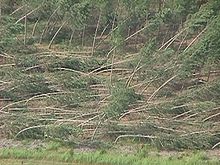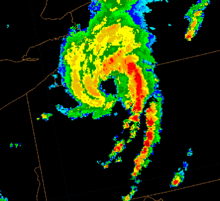High winds are known to cause damage, depending upon their strength. Infrequent wind gusts can cause poorly designed suspension bridges to sway. When wind gusts are at a similar frequency to the swaying of the bridge, the bridge can be destroyed more easily, such as what occurred with the Tacoma Narrows Bridge in 1940.[132] Wind speeds as low as 23 knots (43 km/h) can lead to power outages due to tree branches disrupting the flow of energy through power lines.[133] While no species of tree is guaranteed to stand up to hurricane-force winds, those with shallow roots are more prone to uproot, and brittle trees such as eucalyptus, sea hibiscus, and avocado are more prone to damage.[134] Hurricane-force winds cause substantial damage to mobile homes, and begin to structurally damage homes with foundations. Winds of this strength due to downsloped winds off terrain have been known to shatter windows and sandblast paint from cars.[53] Once winds exceed 135 knots (250 km/h), homes completely collapse, and significant damage is done to larger buildings. Total destruction to man-made structures occurs when winds reach 175 knots (324 km/h). The Saffir-Simpson scale and Enhanced Fujita scale were designed to help estimate wind speed from the damage caused by high winds related to tropical cyclones and tornadoes, and vice versa.
Tornadoes
A dangerous rotating column of air in contact with both the surface of the earth and the base of a cumulonimbus cloud (thundercloud) or a cumulus cloud, in rare cases. Tornadoes come in many sizes but typically form a visible condensation funnel whose narrowest end reaches the earth and surrounded by a cloud of debris and dust.[17]
Tornadoes wind speeds generally average between 40 miles per hour (64 km/h) and 110 miles per hour (180 km/h). They are approximately 250 feet (76 m) across and travel a few miles (kilometers) before dissipating. Some attain wind speeds in excess of 300 miles per hour (480 km/h), may stretch more than a mile (1.6 km) across, and maintain contact with the ground for dozens of miles (more than 100 km).[18][19][20]
Tornadoes, despite being one of the most destructive weather phenomena are generally short lived. A long-lived tornado generally lasts no more than an hour, but some have been known to last for 2 hours or longer (for example, the Tri-State Tornado). Due to their relatively short duration, less information is known about the development and formation of tornadoes.[21]
Downburst
Downbursts are created within thunderstorms by significantly rain-cooled air, which, upon reaching ground level, spreads out in all directions and produce strong winds. Unlike winds in a tornado, winds in a downburst are not rotational but are directed outwards from the point where they strike land or water. “Dry downbursts” are associated with thunderstorms with very little precipitation,[22] while wet downbursts are generated by thunderstorms with large amounts. Microbursts are very small and macrobursts are large-scale downbursts.[23] The heat burst is created by vertical currents on the backside of old outflow boundaries and squall lines where rainfall is lacking. Heat bursts generate significantly higher temperatures due to the lack of rain-cooled air in their formation.[24] Derechos are longer, usually stronger, forms of downburst winds characterized by straight-lined windstorms.[25][26]
Downbursts create vertical wind shear or microbursts, which are dangerous to aviation.[27] They can also cause tornado-like damage on the ground and, depending on the size of the downburst, can generate winds at speeds of up to 168 miles per hour (270 km/h). Downbursts also occur much more frequently than tornadoes, with ten downburst damage reports for every one tornado.[28]
Squall line
A squall line is an elongated line of severe thunderstorms that can form along or ahead of a cold front.[29][30] The squall line typically contains heavy precipitation, hail, frequent lightning, strong straight line winds, and possibly tornadoes or waterspouts.[31] Severe weather in the form of strong straight-line winds can be expected in areas where the squall line forms a bow echo, in the farthest portion of the bow.[32] Tornadoes can be found along waves within a line echo wave pattern (LEWP) where mesoscale low pressure areas are present.[33] Some[which?] summer bow echoes are called derechos, and move quickly over large territories.[25] A wake low or a mesoscale low pressure area forms behind the rain shield (a high pressure system under the rain canopy) of a mature squall line and is sometimes associated with a heat burst.[34]
Squall lines often cause severe straight-line wind damage, and most non-tornadic wind damage is caused from squall lines.[35] Although the primary danger from squall lines is straight-line winds, some squall lines also contain weak tornadoes.[35]
Tropical cyclone
Very high winds can be caused by mature tropical cyclones (called hurricanes in the United States and Canada and typhoons in eastern Asia). A tropical cyclone’s heavy surf created by such winds may cause harm to marine life either close to or upon the surface of the water, such as coral reefs.[36] Coastal regions may receive significant damage from a tropical cyclone while inland regions are relatively safe from the strong winds, due to their rapid dissipation over land. However, severe flooding can occur even far inland because of high amounts of rain from tropical cyclones and their remnants.




0 Comments